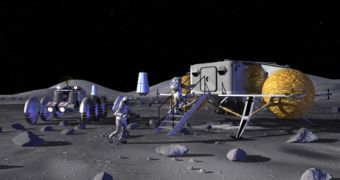We have barely escaped from an Armageddon. Next time we may not be that lucky.
That's why some see the moon as our possible escape in case such a scenario happens. NASA is already planning a permanent lunar outpost by 2024.
"But that plan should be expanded to include a way to preserve humanity's learning, culture, and technology if Earth is hit by a doomsday asteroid or comet," said Jim Burke, a scientist at NASA's Jet Propulsion Laboratory in California, project manager on some of the earliest American lunar landings, and now head of an International Space University investigating survival after a collision with a near-Earth object. "An impact of the size that wiped out the dinosaurs hasn't happened since long before the rise of humans," he pointed out.
But craters left by asteroids throughout the solar system signal that Earth is still very exposed to a civilization-crushing collision. "This calls for the creation of a space age Noah's ark," Burke said.
NASA's recently launched Phoenix Mars Lander, for instance, has a mini-disc inscribed with stories, art, and music. "Rebuilding the terrestrial Internet, plus an Earth-moon extension of it, should be a priority," Burke said.
The members of Alliance to Rescue Civilization (ARC) said that extending the Internet from the Earth to the moon could save technological achievement following an age of "nuclear war, acts of terrorism, plague, or asteroid collisions."
A moon-based repository of Earth's life and human-staffed facilities would "preserve backups of scientific and cultural achievements and of the species important to our civilization. In the event of a global catastrophe, the ARC facilities will be prepared to reintroduce lost technology, art, history, crops, livestock, and, if necessary, even human beings to the Earth," said ARC's Robert Shapiro, a biochemist at New York University.
If the moon outpost of the 2024 grows into a city, "it is possible that a whole new phase in civilization may develop-the branching of history into one stream on Earth and another on the moon," said Burke.
But others signal that the moon archive is just Plan B. "Plan A involves creating an international network of astronomers to scan space for asteroids and comets that might threaten Earth, a global task force to formulate a strategy to prevent impacts with the planet, and a new generation of spacecraft to carry out these missions," said Kilian Engel, an instructor at the International Space University.
NASA already conducts a "Spaceguard Survey", with the goal of detecting near-Earth objects larger than 0.62 mi (1 km) in diameter. In March, 2007, a NASA report showed that nuclear explosions are 10-100 times more effective in rejecting killer asteroids than non-nuclear variants are.
Still, "30 to 80 % of potentially hazardous near-Earth objects are in orbits that are beyond the capability of current or planned launch systems," the report said. But for now, launching hydrogen bombs into space "is prohibited by the Outer Space Treaty of 1967," said Burke.
However, UN members, based on astronomers' data, could amend this treaty for a possible asteroid menace.

 14 DAY TRIAL //
14 DAY TRIAL //